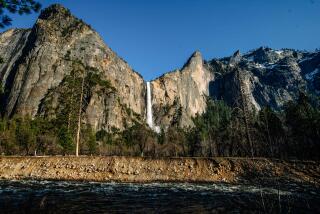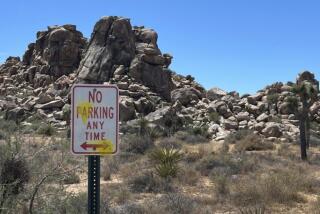Park Taggers Cover Their Markings on Canyon Walls : Graffiti: The vandals are caught in the Angeles National Forest. But they show little remorse while doing community service.
With the same deft touch he used to deface federal property, Jesus Solis aimed a paintbrush Saturday at a graffiti-covered rock in Angeles National Forest and erased his tag.
But the action did little to wipe out his desire to repeat the crime.
“We did it, so it’s just like we have to buff it up,” shrugged Solis, a 20-year-old bellboy who works at a Simi Valley hotel. “We done community service before.”
Solis’ lack of remorse did not surprise Officer Mike Alt of the U.S. Forest Service, who cited him and eight of his companions last weekend on suspicion of using bright blue and black paint to deface boulders along Big Tujunga Road and a quarter-mile section of Big Tujunga Creek.
Solis’ crew, which he said goes by name “129 KNL,” for “Kings n’ Lords,” agreed to clean up the mess in lieu of prosecution.
But Alt had no illusions about what moral lessons the self-proclaimed homeboys would draw from the work.
“These knuckleheads don’t care about anything,” Alt said. “But at least part of the area got cleaned up.”
Graffiti has become nearly as commonplace in the 693,000-acre forest as mosquitoes. Vandals frequently strike picnic grounds after dark and even wade out into the middle of streams to tag hard-to-reach rocks.
The assault has overwhelmed forest rangers, who are rarely able to prove tagging charges.
Solis and his crew weren’t so lucky.
Alt was patrolling Big Tujunga Road last Sunday when he spotted fresh graffiti on rocks off the shoulder of the narrow, winding road. After stopping to inspect the damage he noticed a yellow van parked nearby and peered in through the windshield.
Someone had written the moniker “Hektor” in the dust on the dashboard, and the tag was an exact match with those scrawled on the nearby rocks.
Realizing that the taggers were still in the area, Alt followed the path along the stream, passing more scarred rocks along the way.
When he reached Solis’ crew and saw their paint-stained clothes, the youths confessed, Alt said. He then offered them community service, which they accepted, in lieu of fines ranging from $100 to $1,000.
Alt said he was lenient with the crew only because the evidence against them was largely circumstantial. Federal magistrates frequently dismiss charges unless taggers are caught in the act, Alt said.
Three crew members, including Solis, showed up Saturday to paint wet cement over their monikers.
“We didn’t come out to tag that day,” a 17-year-old member of the crew said Saturday. “We came out to swim, but pretty soon, someone had a spray can out and soon everyone wrote too.”
Solis said he and another crew member were caught two years ago covering an RTD bus with graffiti and were sentenced to work at the Foothill Police Station in Pacoima instead of going to jail or paying fines.
But sweeping floors and cleaning restrooms there didn’t discourage them from further acts of vandalism.
“Landmarkin’ is cool because others can see where you been,” said Solis, referring to the act of defacing natural surfaces like rocks. “It doesn’t get erased the next day like other stuff you do.
“Some people think it looks ugly and other people think it looks good,” he added. “If it’s your tag, it looks good.”
More to Read
Sign up for Essential California
The most important California stories and recommendations in your inbox every morning.
You may occasionally receive promotional content from the Los Angeles Times.










